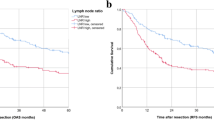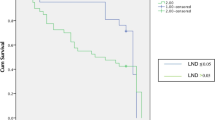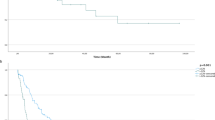Abstract
Background
Lymph node density (LND) is superior to TNM nodal status in predicting survival after surgery for bladder and other cancers. Little is known, however, about whether LND can predict survival in patients with oral squamous cell carcinoma (OSCC). We therefore evaluated the utility of LND for predicting survival for patients with OSCC and positive nodes (pN+).
Methods
We reviewed the clinical, pathologic, and follow-up data of 211 OSCC patients who underwent surgery. All lymph nodes harvested from neck dissection were carefully examined, with LND calculated as the ratio of positive lymph nodes to total lymph nodes removed. Univariate and multivariate analyses of variables predicting overall survival (OS) and disease-specific survival (DSS) were performed for all patients and in pN+ patients.
Results
Kaplan-Meier analyses showed that the 5-year OS and DSS rates in all patients were 72% and 79%, respectively. Multivariate analysis showed that variables independently prognostic for DSS were T classification (hazard ratio [HR] = 2.97, 95% confidence interval [95% CI] = 1.59–5.57; P = .001), and N classification (HR = 4.91, 95% CI = 2.47–9.75; P < .001). In pN+ patients, univariate analysis showed that T classification, >2 positive nodes, and LND >0.06 (median) were significant predictors of DSS (P < .015 each), and multivariate analysis showed that LND was an independent predictor of DSS (HR = 3.24, 95% CI = 1.61–6.53; P = .001).
Conclusions
LND may be useful in stratifying the likelihood of survival in patients with OSCC.




Similar content being viewed by others
References
Jemal A, Siegel R, Xu J, Ward E. Cancer statistics, 2010. CA Cancer J Clin. 2010;60:277–300.
Tankere F, Camproux A, Barry B, Guedon C, Depondt J, Gehanno P. Prognostic value of lymph node involvement in oral cancers: a study of 137 cases. Laryngoscope. 2000;110:2061–5.
Sano D, Myers JN. Metastasis of Squamous cell carcinoma of the oral tongue. Cancer Metastasis Rev. 2007;26:645–62.
Funk GF, Karnell LH, Robinson RA, Zhen WK, Trask DK, Hoffman HT. Presentation, treatment, and outcome of oral cavity cancer: a national cancer data base report. Head Neck. 2002;24:165–80.
Woolgar JA, Rogers S, West CR, Errington RD, Brown JS, Vaughan ED. Survival and patterns of recurrence in 200 oral cancer patients treated by radical surgery and neck dissection. Oral Oncol. 1999;35:257–65.
Greene FL, Page DL, Fleming ID, Fritz A, Balch CM, Haller DG, et al. eds. AJCC cancer staging manual. 6th ed. New York: Springer-Verlag, 2002:23–32.
Shingaki S, Takada M, Sasai K, Bibi R, Kobayashi T, Nomura T, et al. Impact of lymph node metastasis on the pattern of failure and survival in oral carcinomas. Am J Surg. 2003;185:278–84.
Kowalski LP, Bagietto R, Lara JR, Santos RL, Silva JF Jr, Magrin J. Prognostic significance of the distribution of neck node metastasis from oral carcinoma. Head Neck. 2000;22:207–14.
Herr HW. Superiority of ratio based lymph node staging for bladder cancer. J Urol. 2003;169:943–5.
Kassouf W, Agarwal PK, Herr HW, Munsell MF, Spiess PE, Brown GA, et al. Lymph node density is superior to TNM nodal status in predicting disease-specific survival after radical cystectomy for bladder cancer: analysis of pooled data from MDACC and MSKCC. J Clin Oncol. 2008;26:121–6.
Ooki A, Yamashita K, Kobayashi N, Kikuchi S, Katada N, Kobayashi N, et al. Lymph node metastasis density and growth pattern as independent prognostic factors in advanced esophageal squamous cell carcinoma. World J Surg. 2007;31:2184–91.
Gil Z, Carlson DL, Boyle JO, Kraus DH, Shah JP, Shaha AR, et al. Lymph node density is a significant predictor of outcome in patients with oral cancer. Cancer. 2009;115:5700–10.
Robbins KT, Clayman G, Levine PA, Medina J, Sessions R, Shaha A, et al. Neck dissection classification update: revisions proposed by the American Head and Neck Society and the American Academy of Otolaryngology—Head and Neck Surgery. Arch Otolaryngol Head Neck Surg. 2002;128:751–8.
Ferlito A, Devaney KO, Rinaldo A, Devaney SL, Carbone A. Micrometastases: have they an impact on prognosis? Ann Otol Rhinol Laryngol. 1999;108:1185–9.
Capote A, Escorial V, Muñoz-Guerra MF, Rodríguez-Campo FJ, Gamallo C, Naval L. Elective neck dissection in early-stage oral squamous cell carcinoma—does it influence recurrence and survival? Head Neck. 2007;29:3–11.
Shah JP, Candela FC, Poddar AK. The patterns of cervical lymph node metastases from squamous carcinoma of the oral cavity. Cancer. 1990;66:109–13.
Brennan S, Corry J, Kleid S, Porceddu S, Yuen K, Rischin, et al. Prospective trial to evaluate staged neck dissection or elective neck radiotherapy in patients with CT-staged T1-2 N0 squamous cell carcinoma of the oral tongue. Head Neck. 2010;32:191–8.
Lim YC, Lee JS, Koo BS, Kim SH, Kim YH, Choi EC. Treatment of contralateral N0 neck in early squamous cell carcinoma of the oral tongue: elective neck dissection versus observation. Laryngoscope. 2006;116:461–5.
Ferlito A, Silver CE, Rinaldo A. Elective management of the neck in oral cavity squamous carcinoma: current concepts supported by prospective studies. Br J Oral Maxillofac Surg. 2009;47:5–9.
Shingaki S, Nomura T, Takada M, Kobayashi T, Suzuki I, Nakajima T. The impact of extranodal spread of lymph node metastases in patients with oral cancer. Int J Oral Maxillofac Surg. 1999;28:279–84.
Liao CT, Chang JT, Wang HM, Ng SH, Hsueh C, Lee LY, et al. Preoperative [18F]fluorodeoxyglucose positron emission tomography standardized uptake value of neck lymph nodes predicts neck cancer control and survival rates in patients with oral cavity squamous cell carcinoma and pathologically positive lymph nodes. Int J Radiat Oncol Biol Phys. 2009;74:1054–61.
Dixit S, Vyas RK, Toparani RB, Baboo HA, Patel DD. Surgery versus surgery and postoperative radiotherapy in squamous cell carcinoma of the buccal mucosa: a comparative study. Ann Surg Oncol. 1998;5:502–10.
Parsons JT, Mendenhall WM, Stringer SP, Cassisi NJ, Million RR. An analysis of factors influencing the outcome of postoperative irradiation for squamous cell carcinoma of the oral cavity. Int J Radiat Oncol Biol Phys. 1997;39:137–48.
Fan KH, Wang HM, Kang CJ, Lee LY, Huang SF, Lin CY, et al. Treatment results of postoperative radiotherapy on squamous cell carcinoma of the oral cavity: coexistence of multiple minor risk factors results in higher recurrence rates. Int J Radiat Oncol Biol Phys. 2010;77:1024–9.
Ferlito A, Rinaldo A, Devaney KO, MacLennan K, Myers JN, Petruzzelli GJ, et al. Prognostic significance of microscopic and macroscopic extracapsular spread from metastatic tumor in the cervical lymph nodes. Oral Oncol. 2002;38:747–51.
Woolgar JA, Rogers SN, Lowe D, Brown JS, Vaughan ED. Cervical lymph node metastasis in oral cancer: the importance of even microscopic extracapsular spread. Oral Oncol. 2003;39:130–7.
Kell MR, Winter DC, O’Sullivan GC, Shanahan F, Redmond HP. Biological behaviour and clinical implications of micrometastases. Br J Surg. 2000;87:1629–39.
Civantos FJ, Zitsch RP, Schuller DE, Agrawal A, Smith RB, Nason R, et al. Sentinel lymph node biopsy accurately stages the regional lymph nodes for T1-T2 oral squamous cell carcinomas: results of a prospective multi-institutional trial. J Clin Oncol. 2010;28:1395–400.
Robbins KT, Shaha AR, Medina JE, Califano JA, Wolf GT, Ferlito A, et al. Consensus statement on the classification and terminology of neck dissection. Arch Otolaryngol Head Neck Surg. 2008;134:536–8.
Roh JL, Yoon YH, Kim SY, Park CI. Cervical sensory preservation during neck dissection. Oral Oncol. 2007;43:491–8.
Author information
Authors and Affiliations
Corresponding author
Rights and permissions
About this article
Cite this article
Kim, S.Y., Nam, S.Y., Choi, SH. et al. Prognostic Value of Lymph Node Density in Node-Positive Patients with Oral Squamous Cell Carcinoma. Ann Surg Oncol 18, 2310–2317 (2011). https://doi.org/10.1245/s10434-011-1614-6
Received:
Published:
Issue Date:
DOI: https://doi.org/10.1245/s10434-011-1614-6




